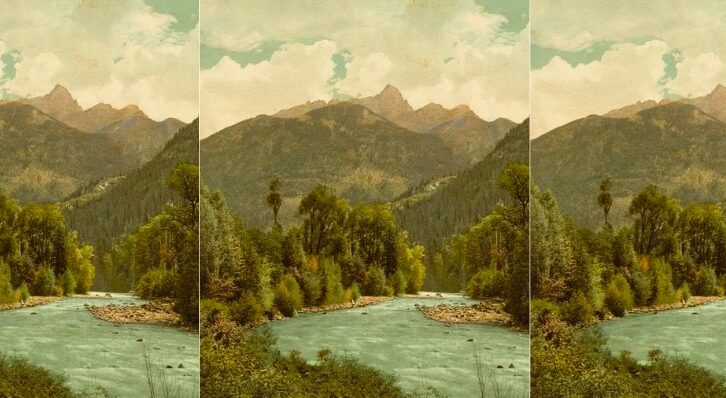
From the Reservation to the River: On the Complexities of Writing About a Native Childhood
Deborah Taffa on Acknowledging America’s Genocide of Native People
The highway to Silverton, Colorado, is an ear-popping ascent with hairpin turns and missing guardrails. Dad hugged the mountainside with the van as we climbed, tapping his horn before each blind curve to warn truckers of our presence. We had left the hellish reservation border town we’d just moved to behind and were headed to a vacation paradise located past a ski resort named Purgatory.
As soon as Dad pulled into our favorite camping spot on the Animas River, I jumped out of the van and ran down to the water. At the age of twelve, I was still knobby-kneed and tube-socked, my brown skin splattered with mud. How lucky it felt to be a kid, unhindered by a woman’s body. My bones remained hollow and birdy that summer, boyish and inconsequential for a few more blissful months.
Tell me your favorite childhood memory, and I’ll tell you who you are. I remember the laughter my sisters and I shared as we tossed tiny balls of bread to see-through fish along the shoreline. I remember Dad fiddling with the worms he used for bait, and Mom asking a kayaker about a rapid called Mandatory Thrashing. I remember all of us working together to pitch the tent and make a temporary home.
Our time on the river felt like spiritual repair. Dad grilled the trout we’d caught during the day. He whittled long marshmallow sticks, and we sat around the fire, listening to his reservation ghost stories—the fog wall that rose one night when his buddies chanted Indian songs, the mountain lion girl that scared him as a kid. Dad burned with energy, and long after the moon rose in the sky, he kept talking. We’d go to bed exhausted, knowing that in the morning he would heat our shoes by the fire he stoked at sunrise.
Nostalgia plays tricks on memory, and the Animas River is consistently sepia tinted in my mind. Dad was always my hero anyway, so when I remember him at the river, I remember his bonfire stories, or the way he used to let us touch the dent in his skull where he got shot by his brother’s arrow—I don’t stop to think about his anger, or his strict rules, or how often he was gone. I don’t dwell on his workaholic ways or consider the overbearing weight he and Mom placed on us to excel.
Remembering the river helps me forget, at least for a moment, the challenges, fears, and feelings of inadequacy I experienced in my childhood.
Remembering the river helps me forget, at least for a moment, the challenges, fears, and feelings of inadequacy I experienced in my childhood. Memoria praeteritorum bonorum, my own set of rose-colored glasses. A trick of the mind that helps me highlight the peaceful days, the quiet ones that punctuated the violence, pressures, and confusion of being a Native girl in a northwestern New Mexico town where cowboys still hated Indians—three white teenagers had murdered three Native men just before my family and I moved there for my father’s new job, when I was six years old.
Navajo people marched in the streets that April, and though we missed the protests and backlash, the town’s tension remained consistent, even after the Civil Rights Commission came in to keep the peace.
My early childhood took place in an era when good Native families didn’t move off their home reservations, because close friends and relatives called relocation a betrayal. It was a time of conflicting choices, when young people like my father and his siblings, who grew up on the reservation, faced a dilemma that pitted high reservation unemployment and double-digit inflation against the desire to belong to their tribe.
In moving from our Quechan (Yuma) reservation in California to the Navajo reservation in New Mexico, my father chose to be an individual, and my parents decided they wanted their kids to be mainstream Americans, passing down an implicit appreciation of social climbing along with and in conflict with the realization that our people are excluded, ironically, from the central mythologies of the American identity.
I want to say ours is the iconic American story, but that would insult our non-Native allies, the decent folk for whom the consequences of broken treaties and forced assimilation are already a burden, and for whom oppression may also be an inheritance. I don’t tell this story to create a divide. I tell it because there are too many dark corners in America that can be relieved of persistent shadows by shining a little light. I tell it because our story belongs to all Americans, some of whom may be surprised by our history. I tell it to celebrate our survival as a culture, as well as the hope, strength, and grace of my family.
This story is as common as dirt. Thousands of Native Americans in California, Arizona, and New Mexico could tell it. Anyone with a grandpa who was haunted by Indian boarding school, who stung his family like a dust devil when he drank. Anyone with a grandma who washed laundry until her fingernails cracked and bled, who went without eating when there weren’t enough groceries because she wanted her ten kids to have a few extra bites.
Anyone with a mother who kept secrets so her kids wouldn’t find out about their father’s jailbird past. Anyone with a father who chose the violence of industrial labor over the violence of reservation life because he wanted his kids to get through private school and make better lives for themselves.
With the help of the U.S. Army, the California legislature distributed weapons to vigilantes, who raided Native homes and killed 100,000 of my ancestors in the first two years of the Gold Rush alone.
So many people could tell this story, it is shocking how rarely it has been told. Too many mothers have watched their kids thrown into cop cars without protest. Too many aunties have put ice on black eyes without saying a word. Too many grandmothers have watched their grandchildren, their hope for the future, head out to a party and never come home. Too many girls have pretended nothing happened after experiencing sexual harassment, only to redirect the hate toward the innocent face staring back at them in the mirror.
Native memoirs are rare because there are rules on Indian reservations. We fear appropriation and fight about who has the right to speak. Talking to outsiders is taboo. And our belief systems often go against this kind of preservation and self-telling. So why divulge my story? Because I want Native kids to feel more connected and less lonely. Because I hate the portrayal of my people as dependents unable to better their own circumstances and tell their own stories. Because I need to understand what aspects of my personality were seeded in that New Mexican town all those years ago.
*
My inheritance stretches back to the so-called Anasazi, over a thousand years in the cacti, sage, and sandstone lands, in the desert canyons, adobe homes, and turquoise stone Southwest. America runs like a river through my veins, yet throughout my childhood, Native representation gathered dust in museums. On television, in books, I saw costumes and mascots—never a portrayal of a mixed-tribe Native girl listening to music on her Walkman. Without a contemporary likeness of myself in the media, there was no confirmation that anything I experienced in my childhood was real.
My father was born in 1941 and he taught me never to confuse pity with comprehension. His Quechan (Yuma) grandfather was born in a time when California’s Indian population had plummeted ninety percent because of foreign diseases, Catholic slave-labor, and the government’s hiring of private militia to bring in Indian scalps.
California’s first governor, Peter Hardeman Burnett, openly promoted genocide, calling for “a war of extermination” in his 1851 second state address. With the help of the US Army, the California legislature distributed weapons to vigilantes, who raided Native homes and killed 100,000 of my ancestors in the first two years of the Gold Rush alone. The legislature paid $1.1 million to these murderers, and when it was done, the US Congress agreed to reimburse the state.
When I was younger, I avoided writing about these atrocities. I told myself it sounded conceited. To have survived that much violence, my ancestors must have been powerful. It was like I was claiming to have super genes.
Today I know my hesitation was shame: the silence that follows an apocalypse. To talk about what we suffered, to concede that we were victims, was not something we did in my family.
And yet to write about the culture that was taken via the government’s assimilation policies, I must acknowledge the pain and remember the beauty in the middle-class life my parents jerry-rigged for me and my siblings in the high-desert arroyos and sun-scorched histories of the American Southwest.
I was raised to believe in the reciprocity of the land, and I know that, if I went back now, I would see that our favorite camping spot near Purgatory has aged just as much as me. During my childhood in the 1980s, my family and I were fishing on the shores of change. The Animas was the last free-flowing water in Colorado before it was dammed at the start of the twenty-first century; a bald eagle refuge not yet injured by the waste-water that bled from the Gold King Mine in 2015.
Dad said the river’s full name was the Río de las Ánimas Perdidas, or the River of Lost Souls. He said if we got up early, we might get lucky and see them: the spirits of our ancestors floating downstream in the early morning fog.
______________________________

From the book Whiskey Tender by Deborah Taffa. Copyright © 2024 by Deborah Taffa. Published by Harper, an imprint of HarperCollins Publishers. Reprinted by permission.
Deborah Taffa
Deborah Jackson Taffa is the author of Whiskey Tender: A Memoir (Harper, 2024). She is a citizen of the Quechan (Yuma) Nation and Laguna Pueblo. She earned her MFA at the Iowa Writers Workshop, and is the Director of the MFA in Creative Writing Program at the Institute of American Indian Arts (IAIA) in Santa Fe, New Mexico. Her writing has appeared in The Rumpus, Boston Review, Los Angeles Review of Books, A Public Space, Salon, The Huffington Post, Prairie Schooner, The Best Travel Writing, and other outlets.



















